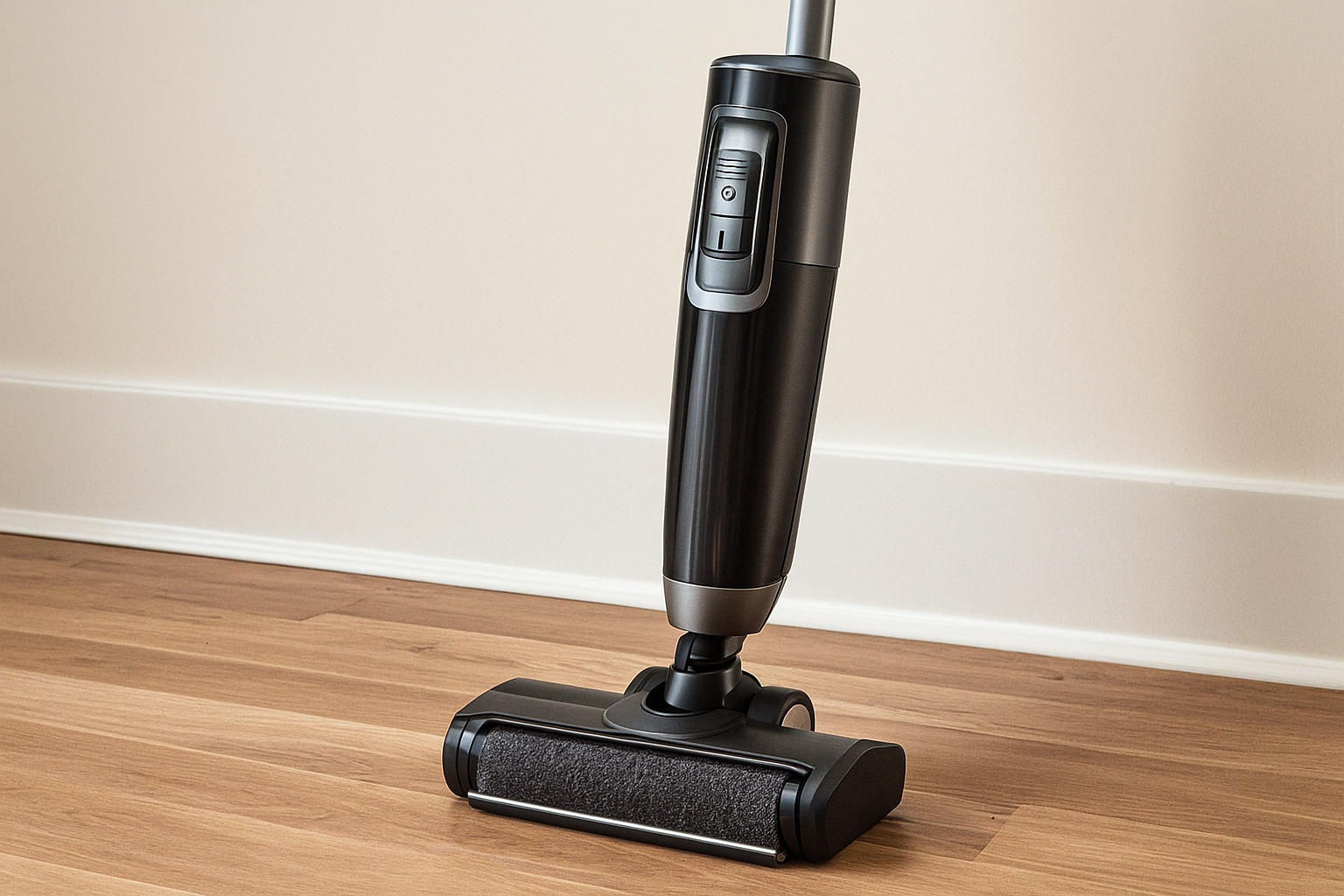
🌍 Introduction: The All-in-One Cleaning Dilemma
In today’s cleaning equipment market, “combo devices”—machines that both vacuum and mop—are marketed as the ultimate convenience.
But for B2B procurement managers, distributors, and engineers, the real question isn’t convenience; it’s efficiency, reliability, and ROI.
Can a single machine truly replace both a dedicated vacuum and a mop system?
Or does combining these two functions inevitably lead to performance compromises?
Let’s explore the engineering reality behind the mop-vacuum hybrid trend and what distributors should evaluate before procurement.
⚙️ Section 1: The Rise of Hybrid Cleaning Devices
The global market for wet dry vacuum cleaners and multi-functional floor cleaning systems has grown rapidly—especially in the hospitality, healthcare, and home appliance sectors.
What’s Driving the Trend?
Labor efficiency: Combining suction and mopping reduces cleaning time by up to 40%.
Compact storage: One device occupies less warehouse and retail space.
Consumer demand: Home users and facility managers prefer simplified cleaning tools.
However, the engineering challenge is enormous: dust and water do not mix easily. Combining them in one unit introduces mechanical, filtration, and hygiene complexities that require careful design.
🧠 Section 2: Engineering Complexity — Why “2-in-1” Is Harder Than It Looks
Building a true mop-vacuum combo isn’t as simple as adding a water tank to a standard vacuum.
It requires rethinking the entire airflow system, filtration path, and fluid management architecture.
1️⃣ Dual-Channel Design
Airflow and water channels must remain isolated to prevent cross-contamination.
Leading models use dual-chamber systems with dedicated intake paths for dry and wet waste.
2️⃣ Filtration Compatibility
Traditional vacuums use HEPA filters, but water introduces moisture and bacterial risk.
Hybrid systems must include anti-bacterial mesh filters or washable filtration cores that handle both dust and liquid safely.
3️⃣ Brush Roll Synchronization
The brush must be rigid enough for debris pickup yet absorbent enough for mopping.
Advanced models use dual-material rollers with microfiber + nylon fibers for balanced performance.
4️⃣ Weight Distribution
Integrating water tanks increases weight. Proper placement and balance ensure smooth maneuverability and minimize user fatigue—vital for commercial use.
🔬 Section 3: Performance Metrics That Matter to Procurement
When evaluating mop-vacuum combos for vacuum cleaner distribution, procurement teams should focus on measurable metrics—not marketing claims.
| Metric | Engineering Relevance | What to Check |
|---|---|---|
| Suction Power | Defines solid waste efficiency | Look for 15–20 kPa minimum under full load |
| Water Flow Control | Prevents overwetting | Adjustable via motorized valves |
| Drying Efficiency | Avoids residue streaks | Check air channel separation and roller speed |
| Maintenance Simplicity | Affects total cost of ownership | Fewer detachable parts = lower service costs |
Machines that score consistently across all four metrics qualify as true dual-function cleaners.
💧 Section 4: Hygiene and Safety — The Hidden Procurement Factor
One of the most overlooked aspects of mop-vacuum combos is cross-contamination.
Mixing wet and dry debris introduces bacterial growth and odor issues if filtration isn’t optimized.
Procurement checklist for hygiene compliance:
Verify separate waste compartments for dry and wet residues.
Prefer models with self-cleaning brush systems.
Require anti-bacterial or silver-ion tank coating for commercial clients.
Ensure filters are washable and easily replaceable.
For B2B buyers in healthcare and hospitality, these specifications aren’t optional—they’re regulatory necessities.
🐾 Section 5: Real-World Application — When Hybrids Shine
Not every use case justifies a mop-vacuum combo. However, in certain environments, the combination offers measurable operational value.
Best Scenarios:
Hotels & Offices: Quick turnaround cleaning for mixed flooring.
Cafés & Restaurants: Frequent liquid spills and fine debris.
Pet-Friendly Facilities: Combos excel at handling pet hair and muddy footprints.
Apartments & Compact Living Spaces: Space-saving storage benefits distributors in urban markets.
In these scenarios, hybrid machines outperform single-purpose vacuums in time efficiency and floor readiness.
🌙 Section 6: Quiet Power — Engineering for Noise-Sensitive Environments
Because hybrid devices operate longer in continuous cleaning cycles, noise reduction is crucial—especially for night-use or public facilities.
A well-designed Quiet Vacuum for Night Use integrates:
Acoustic insulation around the motor housing
Soft roller contact for reduced vibration
Flow-optimized air channels to minimize turbulence
Noise under 65 dB is now considered the standard benchmark for premium hybrid vacuums used in hotels and office facilities.
📊 Section 7: Procurement Strategy — Balancing Innovation and Reliability
For procurement specialists, the challenge isn’t finding the most advanced model, but the most maintainable one.
When sourcing mop-vacuum hybrids, ask these key questions:
Are replacement parts standardized across the series?
What’s the average motor lifespan under dual-mode operation?
How easily can service teams clean or replace internal tubing?
Does the product meet energy efficiency standards (EU ERP / GCC ESMA)?
Procurement success isn’t measured by technology adoption—it’s measured by long-term usability and profitability.
🧩 Section 8: Future Outlook — Convergence and Smart Automation
The next generation of multi-functional durable vacuum cleaners will integrate AI-based floor recognition and auto-fluid management systems.
These devices will detect surface type, adjust suction and water flow dynamically, and even self-dry to prevent mold buildup.
Such advancements will transform hybrid cleaning from a niche convenience to a mainstream professional standard—especially for commercial and B2B applications.
🧭 Conclusion: One Machine, Many Decisions
The idea of a “one-machine-for-all” cleaner is compelling—but only when the design is rooted in engineering precision and lifecycle cost optimization.
For B2B procurement managers and distributors, hybrid systems can deliver real operational benefits—if the model balances suction power, hygiene control, and maintainability.
The mop-vacuum combo isn’t a shortcut—it’s an evolution.
And for those who evaluate it with the right technical and business criteria, it can become one of the most efficient procurement decisions of the decade.
📌 Hashtags
vacuumsprocurement, vacuumcleanerdistribution, LargeCapacityWetDryVacuumCleaner, MultiFunctionalDurableVacuumCleaner, QuietVacuumforNightUse, VacuumCleanerforPetHair, WetDryVacuum, AllSurfaceVacuum, HybridVacuumSystem, SmartCleaningEquipment, EnergySavingVacuum, DualModeVacuum, WetandDryVacuumTechnology, VacuumEngineering, CleaningInnovation, B2BCleaningSolutions, FloorCareTechnology, AutomaticWaterControl, SelfCleaningBrushSystem, VacuumProcurementGuide, NoiseReductionVacuum, HighSuctionVacuumCleaner, CompactCleaningSolutions, MultiFloorVacuum, VacuumCleanerforHotels, CommercialVacuumSystem, ProfessionalVacuumEquipment, MultiPurposeVacuum, IntelligentVacuumCleaner, WetDryCleaningMachine, VacuumCleanerforPetFriendlySpaces, QuietPowerVacuum, AntiBacterialFilterVacuum, FloorCleaningInnovation, OEMVacuum, ODMVacuum, DistributorReadyVacuum, EcoFriendlyVacuum, SmartFloorDetection, CleaningEfficiency, MultiFunctionVacuum, EnergyEfficientVacuum, HospitalityCleaningEquipment, IndustrialVacuumSystem, HybridVacuumTechnology, WetDryFloorCleaner, AllinOneVacuum, B2BVacuumProcurement, VacuumCleanerEngineering, AdvancedCleaningTechnology, GlobalVacuumProcurement
















